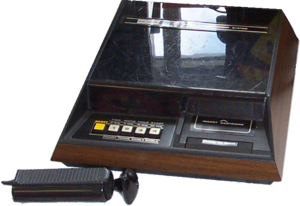b00DaW writes in with his new sequencer project:
“The Fairchild Channel F (VES) was the first programmable ROM console geared toward

the consumer market. It was also originally designed with the ability to output three very out-of-tune tones on a single channel through its internal speaker. Sound obviously wasn’t a major priority; versus cost and playability. Saying this, people still generally had a good opinion of the games for the Fairchild Channel F.
Unfortunately, with the invention and introduction of the Atari 2600 (VCS), the Channel F was utterly destroyed and kicked out of the market due to the superiority of the Atari VCS’s sound, colors, and games. I’m not going to compare the VES to the VCS because truly the VES is at a total loss compared to the VCS. In 1979, Fairchild sold the rights to the Channel F to Zircon. Thinking they’d get a piece of the market, they took the same console, fixed some of the sound architecture, and replaced the internal speaker with a jack-out to a television.
This was deemed the Channel F System II; which also failed in the US of A. However, Europe seemed to
take off pretty well with its many licensed versions of the System II VES consoles.
The System II is the focus of the discussion.
With a little bit of internet-aided archaeology, I was able to discover this console and also a pretty well-documented wiki focused on VES development. By disassembling and reverse-engineering the proprietary F8 assembly code for the game Pro Football, hackers were able to steal and optimize an effectively brilliant way to output all sorts of tones from the original three by essentially modulating one at different duty cycles. This is where my sequencer comes in.
Currently, I am able to output a few octaves of notes with the little-modified Pro Football PlaySong routine. (I have other duty cycles and other effects in the making, but essentially am learning as I go.) Baron Knoxburry, Battle of the Bits father and brother, was able to create a very awesome tune using the first release of the sequencer.
baron_knoxburry_-_fninja_channelf
As you can see, the notes are in tune and even crude percussion is able to be
produced by different tone modulation and placement.
Where is it now?
The state of the sequencer:
- I’m incorporating some standard “noise” routines and other duty cycles to produce lower octaves.
- I’m probably going to change the name of the sequencer.
- From being MML-ish at the moment, the goal is to use a scripting engine like Python or Perl to make it pure MML.
- Also instead of just fruitlessly working the CPU to waste cycles and create lag, I plan on using those cycles to draw pixels on the screen using the frequency values.
So, what’s so cool about this single-channel sequencer for a 1976/1979 failed console? Well, you’re making it do something that it wasn’t originally designed to do for one. Also, this really helps in the aid of sound design. Every millisecond counts since you only have one channel to work with. It’s an intense challenge to
produce quality music from a single channel, limited piece of hardware. This could practically aid in the design for new-age audio to any other chip you decide to “tune.”
